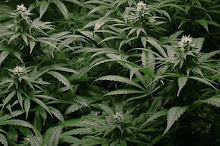Debbie Pfeiffer Trunnell, Staff Writer
Posted: 10/15/2010 08:22:32 PM PDT
Updated: 10/15/2010 08:53:33 PM PDT
The efforts of Harry Anslinger, the first commissioner of the Federal Bureau of Narcotics, with the support of William Randolph Hearst and other staunch opponents, led to the Marijuana Tax Act of 1937, which made it illegal at the federal level.
"Before then it could be found in every corner drugstore," said Lanny Swerdlow, director of the Inland Empire- based Marijuana Anti-Prohibition Project.
There have been many rules and regulations since.
On Nov. 2, Californians will vote on Proposition 19, which, if passed, would change California law to legalize
Richard Portillo of Og Genetics in Hemet provides medical marijuana for marijuana dispensaries and medical marijuana patients with what Portillo says is "high quality genetic marijuana." (LaFonzo Carter Staff Photographer)
marijuana and allow it to be regulated and taxed.
It is the latest in the debate over marijuana use.
Richard Portillo, who runs Hemet-based Og Genetics, helps supply medical marijuana for medical marijuana dispensaries and the patients who rely on them. He calls Proposition 19 a "funny thing" since lawmakers seem to have been constantly "going back and forth" on the issue.
For centuries, it was legal, with Chinese physicians recommending its use 5,000 years ago for pain. The Egyptians used it for the pain of childbirth.
In this country, the Virginia Assembly passed legislation in 1619 requiring every farmer to grow hemp, the fiber that comes from cannabis, or marijuana.
Colonists subsequently set aside part of their gardens to grow hemp, which was used for rope, clothing and ship sails.
"George Washington and Thomas Jefferson both promoted its use, while Benjamin Franklin went to Europe wearing homespun clothing made from hemp," said Jan Werner, vice president of the Clearview Lake Corp., which has medical marijuana dispensaries in Bloomington and Corona.
Although laws were enacted regulating its use, marijuana continued to be used for medicinal and industrial purposes leading up to the 1930s.
After the Marijuana Tax Act, drafted by Anslinger, passed, doctors could no longer prescribe the drug, said Swerdlow.
"The busting and the terrorizing began and it has been going on since," he said.
Although marijuana was ubiquitous in the 1960s, it remained illegal.
In 1996, Proposition 215 was passed in California, allowing patients with a valid doctor's recommendation to possess and cultivate marijuana for personal medical use.
Several other states followed suit.
It remains illegal at the federal level and marijuana dispensaries continue to be in the line of fire in San Bernardino and Riverside counties, said Swerdlow.
And now there is Proposition 19, which would allow people 21 and older to possess, cultivate or transport marijuana for personal use.
The controversial proposition is currently the source of much debate. U.S. Attorney General Eric Holder announced Friday that the proposition won't stop federal drug enforcement.
Tim Rosales, spokesman for Sacramento-based No on Proposition 19, believes it is a badly flawed initiative that will not have the desired effect.
"It essentially carves out special rights for people who use recreational marijuana that could cause a host of other problems," he said. "There are people across the board opposed to it, and we need to go back to the drawing board."
But Swerdlow, a supporter, believes the time is now for the legalization.
"It will raise a lot of revenue for a bankrupt state and allow the police to go out on real crimes," he said. "It's absolutely time because it should never have been made illegal in the first place."
deborah.pfeiffer@inlandnewspapers.com, 909-386-3879





Hey
ReplyDeleteEvery one linke good health so come and know about better health
medical marijuana doctor